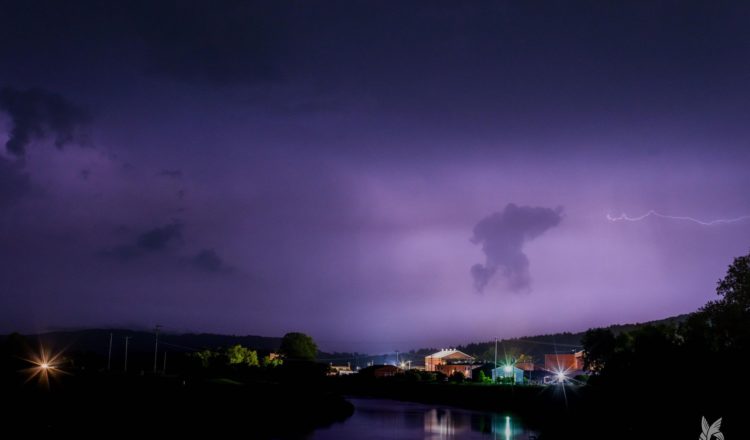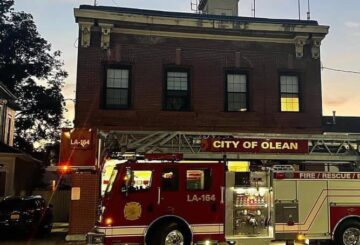Governor Andrew M. Cuomo today directed State agencies to prepare emergency response assets as strong to severe thunderstorms are forecast to move across the state late this afternoon and this evening. Heavy downpours, large hail, damaging winds and dangerous lightning are expected to accompany these storms. In addition, a Heat Advisory has been issued by the National Weather Service for upstate locations as temperatures will approach the mid-to-upper 90s this afternoon. Governor Cuomo urged New Yorkers to prepare for dangerous weather conditions and check local forecasts for the most current forecast.
“Another batch of severe storms will spawn across the State this afternoon, bringing the potential for heavy rain, large hail, and lightning as they move west to east,” Governor Cuomo said. “In addition to the storms, we are also expecting high heat and humidity throughout the day. This administration is mobilized and we stand ready to help local partners if the needed. New Yorkers should keep a very close eye on the weather today, check on neighbors and friends, and make sure they and their loved ones remain safe.”
Thunderstorms are possible later this afternoon and evening across most of the State, except in Long Island and New York City. Temperatures will reach into the mid-90s with winds generally at 5 to 15 mph, except for the Western New York Region, where gusts could reach up to 45 mph. High rainfall amounts up to two or more inches are possible in areas with thunderstorms. Tonight, mostly cloudy skies are expected with rain showers likely and thunderstorms possible statewide, except in the Finger Lakes and Western New York Regions, where only rain showers are likely.
New Yorkers can view weather alerts in their area by visiting the National Weather Service website here.
Agency Preparations
Department of Transportation
The State Department of Transportation is closely monitoring the coming storm and is prepared to respond with the following assets:
- 1,402 large dump trucks
- 308 large loaders
- 78 chippers
- 78 tracked and wheeled excavators
- 22 water tankers
- 17 vacuum trucks with sewer jets
- 15 tree crew bucket trucks
Thruway Authority
The Thruway Authority has 662 operators and supervisors prepared to respond to any wind or flood related issues across the state with small to medium sized excavators, plow/dump trucks, large loaders, portable VMS boards, portable light towers, smaller generators, smaller pumps and equipment hauling trailers, as well as signage and other traffic control devices available for any detours or closures. Variable Message Signs, Highway Advisory Radio and social media are utilized to alert motorists of weather conditions on the Thruway.
Statewide equipment numbers are as follows:
- 227 Large Dump Trucks
- 118 Small Dump Trucks
- 68 Loaders
- 26 Trailers
- 7 Vac Trucks
- 9 Tracked Excavators
- 8 Wheeled Excavators
- 10 Brush Chippers
- 100 Chainsaws
- 22 Aerial Trucks
- 22 Skid Steers
- 88 Portable Generators
- 68 Portable Light Units
The Thruway Authority encourages motorists to download its mobile app which is available to download for free on iPhone and Android devices. The app provides motorists direct access to live traffic cameras, real-time traffic information and navigation assistance while on the go. Motorists can also sign up for TRANSalert e-mails which provide the latest traffic conditions along the Thruway, follow @ThruwayTraffic on Twitter, and visit thruway.ny.gov to see an interactive map showing traffic conditions for the Thruway and other New York State roadways.
New York State Police
The New York State Police has instructed all Troopers to remain vigilant and closely monitor conditions for any problems. Additional personnel will be deployed to affected areas as needed. All four-wheel drive vehicles and all specialty vehicles, including Utility Terrain Vehicles, are in-service.
Department of Environmental Conservation
DEC Environmental Conservation Police Officers, Forest Rangers, Emergency Management staff, and regional staff are on alert and monitoring the developing situation and actively patrolling areas and infrastructure likely to be impacted by severe weather. All available assets, including swift water rescue teams, are positioned to assist with any emergency response.
Office of Parks, Recreation and Historic Preservation
New York State Park Police and park personnel are on alert and closely monitoring weather conditions and impacts. Park visitors should check the parks website here or call their local park office for the latest updates regarding park hours, openings and closings.
Department of Public Service
New York’s utilities have approximately 5,500 workers available to engage in damage assessment, response, and restoration efforts across the State. Department of Public Service staff will track the utilities’ work throughout the storm event and will ensure utilities shift the appropriate staffing to the regions anticipated to be impacted the most.
Thunderstorm Safety Tips
Before the Storm
- Check the weather forecast before leaving for extended periods outdoors.
- If a storm is approaching, keep a NOAA Weather Radio or AM/FM radio with you.
- Watch for signs of approaching storms.
- Postpone outdoor activities if storms are imminent.
- Check on neighbors who require special assistance: infants, the elderly, and people with disabilities.
During the Storm
- If you can hear thunder, you are close enough to the storm to be struck by lightning. Go to safe shelter immediately.
- Move to a sturdy building or car. Do not take shelter in small sheds, under isolated trees, or in convertible automobiles.
- If lightning occurs and sturdy shelter is not available, get inside a hard-top automobile and keep the windows up.
- Get out of boats and away from water.
- Telephone lines and metal pipes can conduct electricity. Unplug appliances not necessary for obtaining weather information. Avoid using the telephone or any electrical appliances. Use phones only in an emergency.
- Get to higher ground if flash flooding or flooding is possible. DO NOT attempt to drive to safety. Most flash flooding deaths occur in automobiles.
High Heat Safety Tips
- Drink plenty of fluids.
- Wear lightweight and loose-fitting clothing when possible.
- Stay in an air-conditioned room and out of the sun.
- Do not leave young children and pets unattended in vehicles under any circumstances.
- If you work or spend time outside, take extra precautions. When possible, reschedule strenuous activities to early morning or evening. To reduce risk during outdoor work, schedule frequent rest breaks in shaded or air-conditioned environments.
- Know the signs and symptoms of heat exhaustion and heat stroke. Anyone overcome by heat should be moved to a cool and shaded location. Heat stroke is an emergency! If you suspect heat-related illness, don’t hesitate – call 9-1-1 immediately.
For more weather safety information, please visit the Division of Homeland Security and Emergency Services website here.
After the storm— Basement flooding? Sump pump not working? Septic issues? Don’t mess around, call Tim Shea







